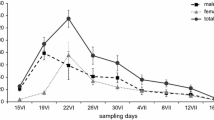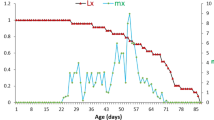Summary
Mortality estimates for the immature stages of two butterfly species, Danaus plexippus and D. chrysippus, were obtained by observing the survival of egg cohorts on different sized patches of food plants (Asclepias spp.), over a one-year period. Losses were variable (0–100%) but usually high (90% and over) throughout the year for both species. Most of the losses in both species occurred in the early stages. The mortality by the third instar accounts for 86–100% of the total losses by instar V. Accordingly both species fall into Price's (1975) type A survivorship category. The size of patches of host plants affected losses. The trend was for increasing losses with increasing patch size. A full life-budget is presented for D. plexippus and implications of the observed mortality levels for competition between the two butterfly species is discussed.
Similar content being viewed by others
References
Brower LP (1962) Evidence for interspecific competition in natural populations of the monarch and queen butterflies, Danaus plexippus and D. gilippus berenice in South Central Florida. Ecology 43:549–552
Common IFB, Waterhouse DF (1972) Butterflies of Australia. Angus and Robertson, Sydney, pp 682
Dempster JP (1969) Some effects of weed control on the numbers of the small cabbage white (Pieris rapae L.) on Brussels sprouts. J appl Ecol 6:339–346
Dethier VG (1959) Food plant distribution density and larval dispersal as factors affecting insect populations. Canad Ent 91:581–596
Ehrlich PR, Gilbert LE (1973) Population structure and dynamics of the tropical butterfly Heliconius ethilla Biotropica 5:69–82
Gilbert LEP (1975) Ecological consequences of a coevolved mutualism between butterflies and plants. In: Gilbert LE, Raven PH (eds) Coevolution of animals and plants. Univ Texas, p 209–240
Harcourt DG (1969) The development and use of life-tables in the study of natural insect populations. Ann Rev Entomol 14:175–196
Orrell J (1970) The baby is a cannibal. Wildlife 7:44–47
Price PW (1975) Insect Ecology. Wiley-Interscience, New York, pp 514
Seber GAF (1973) The Estimation of Animal Abundance. Griffin and Co Ltd, London, pp 506
Smithers CN (1972) Observations on a breeding population of Danaus plexippus (L.) (Lepidoptera: Nymphalidae) at Camden, New South Wales. Aust Zool 17:142–148
Southwood TRE (1966) Ecological Methods. Chapman and Hall, London, pp 391
Urquhart FA (1960) The Monarch Butterfly. Uni Toronto Press, pp 361
Varley GC, Gradwell GR, Hassell MP (1973) Insect Population Ecology: an analytical approach. Blackwell Sci Pub, London, pp 212
Young AM, Moffett MW (1979) Studies on the population biology of the tropical butterfly Mechanites isthmia in Costa Rica. Amer Mid Nat 101:309–319
Zalucki MP (1981 a) Animal movement and its population consequences: with a case study of Danaus plexippus L. Unpub PhD Thesis, Griffith University, Brisbane
Zalucki MP (1981 b) Temporal and spatial variation of mortality in Danaus plexippus L. Aust Ent Mag 8:3–8
Zalucki MP, Kitching RL (1982) The population biology and structure of a continuously breeding population of Danaus plexippus (Aust J Ecol) (Ms in Review)
Zalucki MP, Chandica A, Kitching RL (1981) Quantifying the distribution and abundance of an animal's resource using aerial photography. Oecologia (Berl) 50:176–183
Author information
Authors and Affiliations
Rights and permissions
About this article
Cite this article
Zalucki, M.P., Kitching, R.L. Temporal and spatial variation of mortality in field populations of Danaus plexippus L. and D. chrysippus L. Larvae (Lepidoptera: Nymphalidae). Oecologia 53, 201–207 (1982). https://doi.org/10.1007/BF00545664
Received:
Issue Date:
DOI: https://doi.org/10.1007/BF00545664




